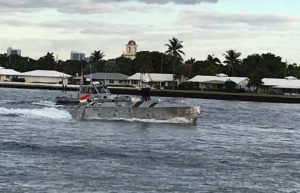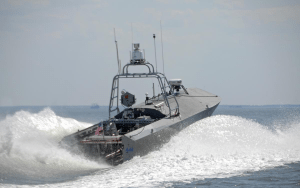The Government Accountability Office (GAO) denied Textron Systems’ [TXT] protest of the Navy’s Mine Countermeasures Unmanned Surface Vehicle (MCM USV) contract, worth up to $123 million, the office said Aug. 10.
The Navy originally awarded the contract to Bollinger Shipyards in April over two other bidders, including Textron, which has worked with the Navy for years on the project. The contract calls for production, engineering services and other costs for three initial MCM USVs at a cost of $14 million with options to procure up to six more vehicles that would raise the total value to $123 million (Defense Daily, April 11).

Textron has worked with the Navy for years, experimenting with MCM USV capabilities with the Common Unmanned Surface Vessel (CUSV) built by the company to tow the Unmanned Influence Sweep System (UISS) in testing.
MCM USV is part of the UISS program that uses the vehicle to tow payloads like the Raytheon Technologies [RTX] AN/AQS-20C sonar, which is used to detect, localize and classify bottom, close-tethered moored and volume moored mines.
The Navy intends to use these new capabilities to partially replace the legacy Avenger-class Mine Countermeasures Ships and MH-53E Sea Dragon helicopters.
GAO’s protest report confirmed that Textron designed and built a prototype MCM USV model that was used in various Navy tests for several years, but the Navy also ordered a technical data package (TDP).
A TDP consists of the technical and manufacturing information needed to build and support a system, which allows the Defense Department to buy the same system from a different supplier later.
According to GAO’s report, the Navy’s solicitation for MCM USV provided the award would be made on a “best-value tradeoff basis,” evaluating based on five factors: focused technical approach, data rights approach, general management and production approach, past performance, and total evaluated cost/price.
The management and past performance factors were evaluated on an acceptable vs. unacceptable basis, while the technical and data rights factors were evaluated using adjectival ratings: outstanding, good, acceptable, marginal and unacceptable. GAO said, when combined, the technical and data rights factors were “significantly more important” than cost.
GAO’s report showed Textron and Bollinger were ranked the same on all adjectival ratings except on technical, where Textron was outstanding while Bollinger was acceptable. Importantly, Textron’s bid was for $158 million while Bollinger’s bid was substantially lower at $107 million.
The source selection authority ultimately concluded that Textron’s “superior overall technical merit [did] not outweigh the significant price premium over Bollinger’s proposal,” so Bollinger was awarded the contract.
Textron filed the protest on April 27. GAO denied the protest in Aug. 1.

GAO noted Textron’s protest is focused largely on the Navy’s evaluation of Bollinger’s proposal, arguing it misevaluated Bollinger’s proposal under technical and management factors, “failing to hold Bollinger to the solicitation’s requirements.”
Textron also argued the Navy’s cost realism evaluation was “improper and inadequate” and the award decision was unreasonable because it was “based on flawed underlying evaluations and because it was made based on cost alone instead of a meaningful best-value tradeoff as required by the solicitation.”
GAO ultimately found that none of Textron’s arguments provide a basis to sustain the protest.
“It is well established that the evaluation of proposals is a matter within the discretion of the contracting agency…An offeror’s disagreement with an agency’s judgment, without more, is insufficient to establish that the agency acted unreasonably…In reviewing an agency’s evaluation, we will not substitute our judgment for that of the agency, but instead will examine the agency’s evaluation to ensure that it was reasonable and consistent with the solicitation’s evaluation criteria and with procurement statutes and regulations,” the report said.
GAO also said that ”essentially, Textron has argued that Bollinger’s proposal could have been more detailed or based on more comparable experience. The agency, however, did not ignore this possibility, as the protester suggests. Rather this consideration was reflected in the Navy’s assessment of Textron’s technical proposal as being more detailed and supported by more comparable experience in this area–which contributed to the assignment of an overall technical rating of outstanding.”
“More to the point, Textron has not established that Bollinger did not meet the requirements defined by the solicitation, in a manner consistent with the agency’s qualitative evaluation and adjectival rating of acceptable,” the decision continued.
GAO also said Textron insisted the Navy “was obligated to dive deeper in a comparison of the offeror’s proposals, calculating and analyzing each offeror’s split between self-performed hours and subcontracted hours and reviewing each category for differences between the offerors.”
However, the Navy argued Textron’s protest arguments are untimely challenges to the solicitation terms, “contending that the heart of Textron’s argument is that the agency should have created a solicitation that an offeror could only satisfy with the experience and knowledge that Textron gained during the UISS contract.”
GAO said it decided the solicitation “cannot reasonably be construed to require the particular experience and specific information that Textron argues.”
GAO also said the Navy’s cost analysis “need not achieve scientific certainty; rather, the methodology employed must be reasonably adequate and provide some measure of confidence that the agency’s conclusions about the most probable costs for an offeror’s proposal are reasonable and realistic in view of other cost information reasonably available to the agency at the time of its evaluation.”
The Navy noted the solicitation, as a build-to-print effort using the TDP, meant the Navy did not specifically require program-specific experience or knowledge.
Notably, the protest decision said while Textron based its engineering support on its earlier MCM USV UISS support work, Bollinger based its support on its work with the Coast Guard Fast Response Cutter.